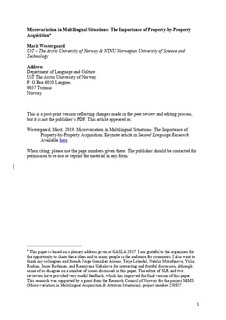| dc.description.abstract | In this article, I argue that first language (L1), second language (L2) and third language (L3) acquisition are fundamentally the same process, based on learning by parsing. Both child and adult learners are sensitive to fine linguistic distinctions, and language development takes place in small steps. While the bulk of the article focuses on crosslinguistic influence in L2/Ln acquisition, I first briefly outline the Micro-cue Model of L1 acquisition (Westergaard, 2009a, 2014), arguing that children build their I-language grammars incrementally, paying attention to small distinctions in syntax and information structure from early on. They are also shown to be conservative learners, generally not producing overt elements or performing movement operations unless there is positive evidence for this in the input, thus minimizing the need for unlearning. I then ask the question how this model fares with respect to multilingual situations, more specifically L2 and L3 acquisition. Discussing both theoretical and empirical evidence, I argue that, although L2 and L3 learners are different from L1 children in that they are not always conservative learners, they are also sensitive to fine linguistic distinctions, in that transfer/crosslinguistic influence takes place on a property-by-property basis. Full Transfer is traditionally understood as wholesale transfer at the initial state of L2 acquisition. However, I argue that it is impossible to distinguish between wholesale and property-by-property transfer in L2 acquisition on empirical grounds. In L3 acquisition, on the other hand, crosslinguistic influence from both previously acquired languages would provide support for property-by-property transfer. I discuss a few such cases and argue for what I call Full Transfer Potential (FTP), rather than Full (wholesale) Transfer, within the Linguistic Proximity Model (LPM) of L3 acquisition. Thus, rather than assuming that ‘everything does transfer’, I argue that ‘anything may transfer’. | nb_NO |
